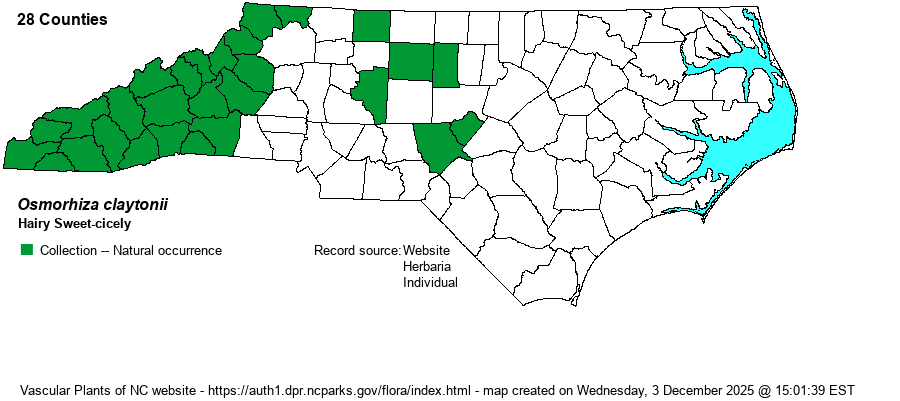| Author | (Michaux) C.B. Clarke | |
| Distribution | Throughout the Mountains; scattered in the central and southeastern parts of the Piedmont, but as O. longistylis is also present in these areas, it is hoped that specimens have been correctly identified.
This is a Northern species, found south to PA and MO, and southward mostly in the mountains, to northern AL and AR. | |
| Abundance | Common in the Mountains; rare to locally uncommon in the Piedmont parts of the range. | |
| Habitat | Both of the two species of Osmorhiza occur in rich hardwood forests. This includes Rich Cove Forests, Basic Mesic Forests, and other moist forests, including bottomland forests. As far as known, the habitats appear to be essentially identical, though this species should be the one found more frequently in the middle and higher elevations. | |
| Phenology | Blooms from April to May, and fruits in May and June. | |
| Identification | The two Osmorhiza species are very similar and easily confused by many people. They are moderately stout, growing to 2-3 feet tall, with branches in the upper portions. The alternate leaves are generally triangular in overall shape, but they are bipinnately or tripinnately divided into smaller segments. Each segment is ovate to triangular in shape, strongly cut and serrated, with each one being about 2 inches long and 1-inch wide at most. The umbels on the branch tips are compound like in most other genera, with numerous small white flowers. In this species, there are usually only 3-5 umbellets per umbel, on rays that are 3-4 inches long, and thus the umbel appears relatively open and uncrowded -- especially as there are only 4-7 flowers per umbellet. In O. longistylis, there are 4-6 umbellets per umbel, on shorter rays (1-2 inches long), and thus the umbel looks rather crowded, especially as there are 9-18 flowers in an umbellet. Other features are that the style in this species is very short, shorter than the petals, whereas in O. longistylis the style is longer than the petals. For other characters, see Weakley (2020) and other keys, though this species has a somewhat hairy stem as opposed to a mostly smooth stem in O. longistylis. The genus should be identified by its growing in rich forests, with strongly triangular-looking leaves, cut more finely into additional triangular-looking segments -- quite fern-like in overall appearance. When you break some leaves, you should get an anise or licorice fragrance, much stronger than in O. longistylis. | |
| Taxonomic Comments | None
| |
| Other Common Name(s) | Bland Sweet-cicely, Clayton's Sweetroot, Aniseroot | |
| State Rank | S5 | |
| Global Rank | G5 | |
| State Status | | |
| US Status | | |
| USACE-agcp | FACU link |
| USACE-emp | FACU link |

